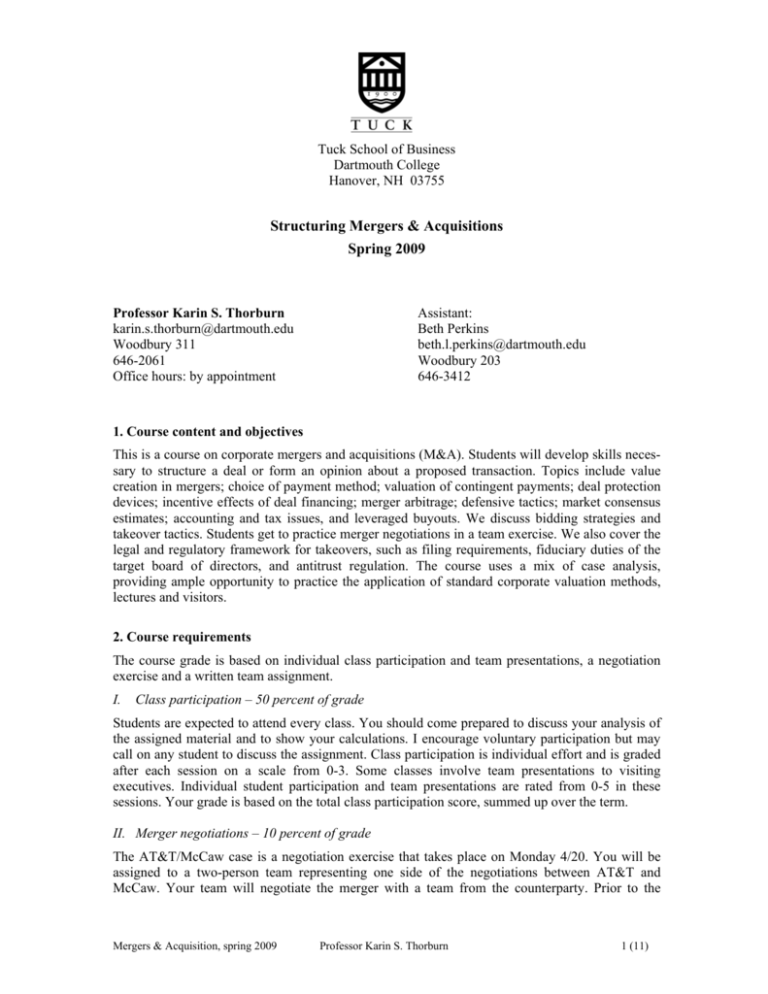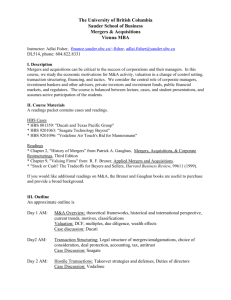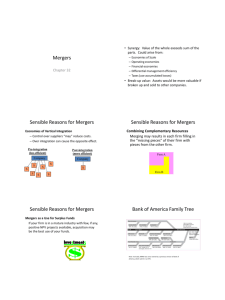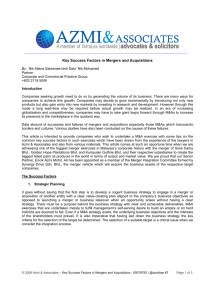
Tuck School of Business
Dartmouth College
Hanover, NH 03755
Structuring Mergers & Acquisitions
Spring 2009
Assistant:
Beth Perkins
beth.l.perkins@dartmouth.edu
Woodbury 203
646-3412
Professor Karin S. Thorburn
karin.s.thorburn@dartmouth.edu
Woodbury 311
646-2061
Office hours: by appointment
1. Course content and objectives
This is a course on corporate mergers and acquisitions (M&A). Students will develop skills necessary to structure a deal or form an opinion about a proposed transaction. Topics include value
creation in mergers; choice of payment method; valuation of contingent payments; deal protection
devices; incentive effects of deal financing; merger arbitrage; defensive tactics; market consensus
estimates; accounting and tax issues, and leveraged buyouts. We discuss bidding strategies and
takeover tactics. Students get to practice merger negotiations in a team exercise. We also cover the
legal and regulatory framework for takeovers, such as filing requirements, fiduciary duties of the
target board of directors, and antitrust regulation. The course uses a mix of case analysis,
providing ample opportunity to practice the application of standard corporate valuation methods,
lectures and visitors.
2. Course requirements
The course grade is based on individual class participation and team presentations, a negotiation
exercise and a written team assignment.
I.
Class participation – 50 percent of grade
Students are expected to attend every class. You should come prepared to discuss your analysis of
the assigned material and to show your calculations. I encourage voluntary participation but may
call on any student to discuss the assignment. Class participation is individual effort and is graded
after each session on a scale from 0-3. Some classes involve team presentations to visiting
executives. Individual student participation and team presentations are rated from 0-5 in these
sessions. Your grade is based on the total class participation score, summed up over the term.
II. Merger negotiations – 10 percent of grade
The AT&T/McCaw case is a negotiation exercise that takes place on Monday 4/20. You will be
assigned to a two-person team representing one side of the negotiations between AT&T and
McCaw. Your team will negotiate the merger with a team from the counterparty. Prior to the
Mergers & Acquisition, spring 2009
Professor Karin S. Thorburn
1 (11)
negotiations your team should hand in a confidential report outlining your opening price, walk
away price and negotiation strategy. After the negotiations you should hand in a report explaining
and justifying the outcome of the negotiations.
III. Term paper – 40 percent of grade
Students will make a thorough analysis of a potential takeover transaction. You should pick a possible bidder and target, justifying why this target is an attractive acquisition for the bidder. The
write-up should provide an analysis of a range of different aspects of the transaction, including the
strategic and economic benefits, bid range, type of consideration, bidding strategy, legal and tax
aspects, anticipated management reaction, and potential competition. The assignment should be
made in groups of 4 students. Students will present their term projects to the class on the last two
sessions of the term. The term paper should incorporate any comments during the presentations
and is due on Friday 5/22.
3. Visitors
The class will be visited by the following speakers:
Mary Amor T’94
Managing Director
Mergers and Acquisitions
Vikram Bhardwaj T’99
Managing Director
Citigroup Global Markets, Mergers & Acquisitions
Stuart M. Cable T’76
Partner
Goodwin Procter LLP
Steven W. Hooper
Partner and Co-Founder
Ignition Partner
Arthur Lindenauer T’59
Chairman
Schlumberger Limited
4. Course materials
The required textbook is “Structuring Mergers & Acquisitions” Peter A. Hunt, 3rd ed., Aspen
Publishers, 2007 (below Hunt).
In addition, the course packet contains a number of cases and readings. Further material and
detailed descriptions of the assignments will be distributed in class.
The readings are quite extensive and should largely be viewed as reference material. Focus your
energy on the analysis of the assigned cases and problems.
Mergers & Acquisitions, spring 2009
Professor Karin S. Thorburn
2 (11)
5. Supplementary readings
The legal side of takeovers is covered in great detail in “Takeovers: A strategic guide to mergers
and acquisitions” by M.M. Brown, R.C. Ferrara, P.S. Bird, G.W. Kubek and W.D. Regner, 2nd ed.,
Aspen Publishers, 2004.
A good review of corporate valuation techniques is found in “Valuation: measuring and managing
the value of companies” by Tim Koller, Mark Goedhart and David Wessels, 4th ed., John Wiley &
Sons, 2005.
For entertainment, you can also read Bruce Wasserstein’s “Big deal: 2000 and beyond”, Warner
Books, 2000, and Robert F. Bruner’s “Deals from hell: M&A lessons that rise above the ashes”,
John Wiley & Sons, 2005.
All books are held on reserve at Feldberg Library.
6. Honor code
Students are encouraged to work in groups when preparing for class. The team assignments should
not be discussed with other teams. You may not use notes or other material from any previous
offering of this or a similar course, or discuss the material with students who have already taken
the course. This restriction extends to case-related information obtained from other sources.
7. Laptops
Laptops should be closed during class. Make sure to bring print-outs of any calculations that you
may want to refer to in the class discussion. If I see an open laptop during class, you will get a
class participation grade of -3 on that day.
Mergers & Acquisitions, spring 2009
Professor Karin S. Thorburn
3 (11)
8. Course overview
Session Date
Day
Topic
Guest speaker
Case, readings in Hunt (H)
1
3/24
Tue
Bid financing
Pinkerton, H:2-6,13
2
3/25
Wed
Value creation in mergers
Chase Manhattan, H:1,7
3
3/30
Mon
Method of payment
Cooper Industries, H:9
4
3/31
Tue
Incentive effects of deal financing
AXA MONY, H:31,32
5
6
4/6
4/7
Mon
Tue
Legal and regulatory issues
Legal and regulatory issues, continued
7
4/13
Mon
Contingent considerations
General Mills/Pillsbury, H:28-29
8
4/14
Tue
Tax and accounting issues
H:12
9
4/20
Mon
Merger negotiations
AT&T/McCaw, H:25-27
10
4/21
Tue
Negotiation strategies
11
4/27
Mon
Evaluating and responding to a bid
Time/Warner, H:17,24
12
4/28
Tue
Defensive tactics
Consolidated Rail (A) and (B), H-23
13
5/4
Mon
Leveraged buyouts
Brazos/CoMark, H:8,10,16,30
14
5/5
Tue
Market consensus and overvaluation effects
Vodafone/Mannesmann, H:15
15
5/11
Mon
Alcan: competition between Alcoa and Rio Tinto
Mary Amor T’94
16
5/12
Tue
Structuring the deal
Vikram Bhardwaj T’99
17
18
5/18
5/19
Mon
Tue
Student term paper presentations
Term paper presentations, continued
Susan and Art
Lindenauer T’59
Mergers & Acquisition, spring 2009
Professor Karin S. Thorburn
Stuart Cable T’76
-“”-
H:21,22
Steven Hooper
4 (11)
Detailed schedule
STRUCTURING MERGERS AND ACQUISITIONS
1. Bid financing
Tuesday 3/24
Course introduction. Target valuation. Financing the acquisition.
Case:
Pinkerton (A), HBS 9-291-051.
Questions:
1. How much is Pinkerton worth to Wathen? Value Pinkerton using DCF and multiples. What
are the different synergies in this deal and what are they worth?
2. What is the value of Pinkerton under American Brands? How much could other bidders pay
for Pinkerton? Are any of the synergies unique to Wathen?
3. Should Wathen finance the $100 million bid with debt or equity? What debt ratio will the
merged firm have if the bid is financed with 75% debt and 100% debt, respectively? Will there
be sufficient cash flow to cover the debt payments?
4. What do you think of the proposed terms for the $25 million equity contribution from the
investment firm? Which financing alternative would you recommend to Wathen?
Note: Some of you have seen this case in Corporate Finance. While the analysis here goes
beyond what you did in the core, you are not allowed to consult your old class notes or case
solutions. Instead, you are expected to prepare the case from scratch.
Readings: Hunt chapters 2-6 and 13.
2. Value creation in mergers
Wednesday 3/25
Motives for mergers and acquisitions. Contribution analysis. Exchange ratios. Antitrust regulation and enforcement.
Case:
Chase Manhattan Corporation: The making of America’s largest bank, HBS 9-298-016.
Case questions:
1. Chemical and Chase are attempting to reduce their costs by merging. This approach
(“bigger is better”) represents a sharp contrast to the refocusing and downsizing which has
characterized much of US restructuring in recent years. Do you think the interest of the
banks’ shareholders and other constituencies would be better served by another form of
restructuring that instead emphasizes increased corporate focus?
2. What are the strategic benefits, if any, of combining Chase and Chemical? What is the
most significant benefit that the banks will realize from this merger?
3. What incentives are there for the two management teams to support this merger?
4. Should Chemical reconsider any of its other prospective merger partners?
5. Assuming that all the anticipated benefits from the merger are realized, what is the likely
dollar impact of the merger on the combined wealth of Chase and Chemical common
stockholders? How will the merger affect the banks’ financial performance (e.g. as measured by return on equity)? How would you measure the success of this transaction? Use an
equity beta for bank common stock of 1.25 and a 10-year US Treasury Bond rate of 6.4%.
Mergers & Acquisition, spring 2009
Professor Karin S. Thorburn
5 (11)
6. How would you determine the share exchange rate? If you were Chemical management,
what exchange ratio would you seek for the merger? What if you were Chase management? Is the exchange rate a deal breaker or are there other features of the transaction that
you might adjust?
Readings: Hunt chapters 1 and 7.
Eckbo, B. Espen, and Karin S. Thorburn, 2000, “Gains to Bidder Firms Revisited: Domestic
and Foreign Acquisitions in Canada,” Journal of Financial and Quantitative Analysis 35,
1-25.
3. Method of payment
Monday 3/30
Valuation of synergies. Choice of consideration. Accretion/dilution analysis. Acquisition
premiums.
Case:
Cooper Industries, Inc. HBS 9-274-116.
Questions:
1. If you were Mr. Cizik of Cooper Industries, would you try to gain control of Nicholson
File Company in May 1972? What makes the target an attractive candidate for Cooper? Is
it a good strategic fit?
2. What is the maximum price that Cooper can afford to pay for Nicholson? Do a DCF
valuation of Nicholson using a WACC of 10%. What are the potential synergies worth?
What do you make of Nicholson's inventory?
3. What exchange ratio can Cooper offer before the acquisition has a dilutive effect on Cooper’s earnings per share (EPS)? Is it important to consider the impact of an acquisition on
EPS? How can decisions based on EPS go wrong?
4. Is it feasible for Cooper to pay with cash or debt finance a cash bid? How does cash
consideration impact EPS?
5. Assume that on March 2, the day before Porter’s offer, Cooper stock closed at $22 and
Nicholson stock at $30. Moreover, assume that Cooper on the evening of May 3 offers
Nicholson shareholders an exchange ratio of 2.0, i.e. 2 Cooper shares per Nicholson share.
If the acquisition goes through, what percentage of the new company will be owned by
Cooper’s former shareholders? What acquisition premium is Cooper offering? What are
the minimum synergies required for this offer to make sense for Cooper’s shareholders?
6. What are the concerns and what is the bargaining position of the each group of Nicholson
stockholders? What must Cooper offer different shareholders in order to acquire their
shares?
Readings: Hunt chapter 9.
Rappaport, Alfred, and Mark L. Sirower, 1999, Stock or cash? The trade-offs for buyers and
sellers in mergers and acquisitions, Harvard Business Review (Nov-Dec), reprint 99611.
Technical notes on equity-linked consideration, part 1: All-stock deals (HBS 9-903-027) and
part 3: Cash-and-stock deals (HBS 9-903-029).
4. Incentive effects of deal financing
Tuesday 3/31
Control compensation payments. Convertible bonds as deal financing. Voting and trading
incentive effects.
Case:
AXA MONY, HBS 9-208-062.
Mergers & Acquisitions, spring 2009
Professor Karin S. Thorburn
6 (11)
Case questions:
1. Why is AXA bidding for MONY? Does the deal make sense for AXA; for MONY
shareholders; and for management? As a MONY shareholder, what concerns would you
have about the deal?
2. How did AXA finance the takeover bid? Explain the structure that AXA used. Why did
AXA use this structure? What effects, if any, do you think this method of financing has on
the likelihood of the deal succeeding?
3. How would you price the ORAN at issue? Is it fairly priced? What does the price of the
ORAN on February 9, 2003, imply for the probability of the deal succeeding? What is the
fair price of MONY stock?
4. Suppose that you hold a position in the ORAN on February 9. Would you want to buy or
sell MONY stock (a) at the “fair” price calculated in question 3 above or (b) at the market
price of $31.55? How do you explain the price of MONY stock on February 9?
5. Suppose that you manage a $2bn hedge fund with a significant stake in MONY and that
on February 10 you receive a phone call asking to buy your stock at above the market
price if you sign over the voting rights with the shares. What considerations would enter
into your decision about whether to sell you MONY stock at $31.55 on February 9?
Readings: Hunt chapters 31 and 32.
5. Legal and regulatory issues
Monday 4/6
The merger agreement. Board fiduciary duties. Parachutes and executive compensation. Deal
protection.
Visitor:
Stuart M. Cable T‘76, Partner, Goodwin Procter LLP
Readings: Hunt chapters 21 and 22.
6. Legal and regulatory issues, continued
Tuesday 4/7
Visitor:
Stuart M. Cable T‘76, Partner, Goodwin Procter LLP
7. Contingent considerations
Monday 4/13
Valuation of contingent value rights. Price protection: floors, caps, and collars.
Case:
General Mills’ acquisition of Pillsbury from Diageo Plc., UVA-F-1326.
Case questions:
1. What are General Mills’ motives for this deal? Estimate the present value of the expected
cost savings.
2. Why was the contingent value right (CVR) included in this transaction? How does the
claw-back affect the attractiveness of the deal from the standpoints of General Mills and
Diageo? How is an earnout different from a CVR, and in what situation should one or the
other be used?
3. How does the contingent payment work? Draw a payoff diagram (a hockey stick diagram)
of the claw-back feature. What option positions should you take to create the same payoff?
Mergers & Acquisitions, spring 2009
Professor Karin S. Thorburn
7 (11)
4. What is the contingent payment worth when the deal is negotiated in July 2000? What is it
worth when shareholders vote on the deal in early December 2000? Use a Black-Scholes
calculator e.g. from Capital Markets.
5. Is this deal economically attractive to General Mills’ shareholders? Would you recommend that shareholders approve or reject the deal?
6. What can the bidder do to protect its shareholders from stock price fluctuations before the
deal is closed? How can the target protect its shareholders?
Readings: Hunt chapters 28 and 29.
Caselli, Stefano, Stefano Gatti, and Marco Visconti, Managing M&A risk with collars, earnouts and CVRs, Journal of Applied Corporate Finance 18 (4), 91-104.
Technical note on considerations: floors, caps, and collars, HBS 9-902-056.
Amobi, Tuna N., 1997, Price protection in stock-swap transactions, Merger & Acquisitions
32, 22-28.
8. M&A accounting and taxation
Tuesday 4/14
Accounting treatment of M&A. Taxation of stock and cash transactions.
Readings: Hunt chapter 12.
Note on M&A accounting and taxation.
9. Merger negotiations
Monday 4/20
Negotiation exercise: negotiating a merger agreement.
Students will be assigned to represent either AT&T or McCaw. Class time will be used for
negotiations in small teams. Each team should hand in confidential pre-negotiation and postnegotiation reports.
Case:
American Telephone & Telegraph (AT&T): The AT&T/McCaw merger negotiation, UVA-F1142, or
McCaw Cellular Communications: The AT&T/McCaw merger negotiation, UVA-F-1143
(not in course packet).
Readings: Hunt chapters 25-27.
Aiello, Robert J., and Michael D. Watkins, 2000, The fine art of friendly acquisition, Harvard
Business Review (Nov-Dec), reprint R00602.
10. Negotiation strategies
Tuesday 4/21
Merger negotiation debriefing: biases in negotiations, effective negotiation strategies.
Visitor:
Steven W. Hooper, Partner and Co-Founder, Ignition Partner
Readings: Giving great advice: An interview with Bruce Wasserstein, 2008, Harvard Business Review
(jan), reprint R0801G.
Mergers & Acquisitions, spring 2009
Professor Karin S. Thorburn
8 (11)
11. Evaluating and responding to a bid
Monday 4/27
Evaluation of a takeover offer. Management response. The duties of the board and the
business judgment rule. Takeover bidding: tender offers, toeholds and markups.
Case:
Time Inc.’s entry into the entertainment industry, HBS 9-293-117. B-case, HBS 9-293-133,
will be distributed in class.
Case questions:
1. How attractive is the merger of Time with Warner? What are the value enhancement
opportunities? What do you think of the proposed exchange ratio of 0.465 per Warner
share? How much synergy is needed to make the merger attractive?
2. What are the motivations of the two management teams to support the merger?
3. What prompted Paramount’s interest in Time?
4. Why are the investment bankers’ valuations so much higher than the market values? What
legal, financial, and restructuring options does Time have to combat the Paramount bid?
To ensure that it is not a target in the future?
5. What would you do as Mr. Munro? How would you explain a decision to reject the Paramount offer at the annual shareholders’ meeting?
Readings: Hunt chapter 17.
Bower, Joseph L., 2001, Not all M&As are alike and that matters, Harvard Business Review
(March), reprint R0103F.
M&A legal context: Basic framework for corporate governance, HBS 9-803-200, and
Standards related to the sale or purchase of a company, HBS 9-904-004.
Sandra Betton, B. Espen Eckbo, and Karin S. Thorburn, 2009, Merger negotiations and the
toehold puzzle,” Journal of Financial Economics 91, 158-178.
12. Defensive tactics
Tuesday 4/28
Hostile takeovers. Preemptive and reactive defensive strategies.
Case:
The Acquisition of Consolidated Rail Corporation (A), HBS 9-298-006, and (B), HBS 9-298095.
Case questions:
1. Why does CSX want to buy Conrail? How much should CSX be willing to pay for it?
2. Why did CSX make a two-tiered offer? What effect does this structure have on the
transaction? As a shareholder in Conrail, would you tender you share to CSX at $92.50 in
the first stage tender offer? Explain why or why not?
3. What are the economic rationales for and the takeover implications of the various provisions in the merger agreement, e.g. no-talk clause, lock-up options, break-up fee and poison pill shareholder rights plan?
4. Why did Norfolk Southern make a hostile bid for Conrail?
5. How much is Conrail worth? In a bidding war, who should be willing to pay more,
Norfolk Southern or CSX?
6. Why does CSX refer to Norfolk Southern’s bid as a “non-bid”? What should Norfolk
Southern do as of mid-January 1997?
7. As a shareholder, would you vote to opt-out of the Pennsylvania antitakeover statue? What
do the capital markets expect will happen?
Mergers & Acquisitions, spring 2009
Professor Karin S. Thorburn
9 (11)
8. What are the costs and benefits of regulating the market for corporate control through statutes such as Pennsylvania’s antitakeover law?
Readings: Hunt chapters 23 and 24.
M&A legal context: Hostile takeovers, HBS 9-904-005.
Bruner, Robert, “Hostile takeovers: A primer for the decision maker”, UVA-F-1362.
13. Leveraged buyouts
Monday 5/4
Value creation in leveraged buyouts: financial structure, earnouts, asset vs. stock purchase.
Case:
Brazos Partners: The CoMark LBO, HBS 9-202-090.
Case questions:
1. What is Brazos’ strategy? How is it differentiated from that of other buyout funds? What
is the GTT (Generation Transfer Transaction)?
2. Why would CoMark be a good candidate for a leveraged buyout? What do you think of
this opportunity?
3. How did Brazos make itself comfortable with the transaction while other funds passed?
What does the planned financial structure look like?
4. Why does CoMark’s management need Brazos? Why don’t they simply make a leveraged
recap?
5. What do you think of the $40 million price for CoMark? Value CoMark using multiples
and the APV method.
6. What are the issues with asset purchase vs. stock purchase? Analyze the tradeoff between
the two methods.
Readings: Hunt chapters 8, 10, 16 and 30.
Technical note on structuring and valuing incentive payments in M&A: Earnouts and other
contingent payments to the seller, UVA-F-1322.
14. Market consensus and overvaluation effects
Tuesday 5/5
Cross-border transactions. Market consensus estimates and information in prices. Merger
arbitrage. Effects of overvaluation.
Case:
Vodafone AirTouch’s Bid for Mannesmann, HBS 9-201-096.
Questions:
1. What is the strategic and economic rationale for Mannesmann’s acquisition of Orange?
Did Mannesmann overpay for Orange?
2. Vodafone AirTouch offered Mannesmann shareholders 53.7 Vodafone AirTouch shares
per Mannesmann share.
a. Describe the stock swap. What was the market value of Mannesmann’s contribution to
the combined firm? As a Mannesmann shareholder, would you accept the current offer?
As a Vodafone shareholder, would you support the proposed transaction? Use an
average exchange ratio of 1₤=€1.5789.
b. Compute the market estimate on December 17, 1999 of Vodafone AirTouch
successfully acquiring Mannesmann. Assume that if the bid fails both firms would
trade at the prices prevailing after the announcement of Mannesmann’s acquisition of
Orange but prior to rumors of Vodafone AirTouch acquiring Mannesmann.
Mergers & Acquisitions, spring 2009
Professor Karin S. Thorburn
10 (11)
c. Assume that the probability of a successful deal is 0.6, what is the market’s estimate of
the implied synergies from the deal?
d. What is the present value of the expected synergies as shown in Exhibit 10 as of March
2000? Assume that the synergies related to revenues and costs grow at 4% annually
past 2006, while savings from capital expenditure don’t extend beyond 2006, and that
the merger will not affect the firm’s level of working capital.
e. UK equities returned 7.7% (in pounds) over the UK risk-free rate for the period 19191993 and 6.8% over the UK risk-free rate for the period 1970-1996. How might this
observation affect the decision of the Vodafone AirTouch shareholders?
3. What hurdles is Vodafone AirTouch going to face to complete its acquisition of Mannesmann? Who is going to be its most likely support? Who is going to resist? Why?
4. Why is Gent so eager to do the deal? Why is Esser fighting so hard?
5. What role do hostile takeovers play? In their absence what mechanisms perform the same
function?
Readings: Hunt chapter 15.
Chapter 21 (Merger arbitrage) in Weston, F., M. Mitchell, and H. Mulherin, 2004,
“Takeovers, Restructuring, and Corporate Governance”, 4th ed., Pearson Prentice Hall.
Technical note on equity-linked consideration, part 2: Announcement effects, HBS 9-903028.
Wyser-Pratte Guy P., “Merger Arbitrage”, Merger & Acquisition Handbook, 2nd ed. by RockRock-Sikora, 1987.
15. Alcan: competition between Alcoa and Rio Tinto
Monday 5/11
Visitor:
Visitor:
Analysis and student presentation of various aspects of a recent transaction.
Mary Amor T’94, Managing Director, Mergers & Acquisitions
16. Structuring the deal
Tuesday 5/12
Vikram Bhardwaj T’99, Managing Director, Citigroup Global Markets, Mergers &
Acquisitions
17. Term paper presentations
Monday 5/18
Student presentations of term papers.
Visitor:
Arthur Lindenauer T‘59, Retired EVP and CFO, Schlumberger Limited
18. Term paper presentations, continued
Tuesday 5/19
Student presentations of term papers.
Visitor:
Arthur Lindenauer T‘59, Retired EVP and CFO, Schlumberger Limited
The term papers are due on Friday 5/22.
Mergers & Acquisitions, spring 2009
Professor Karin S. Thorburn
11 (11)










